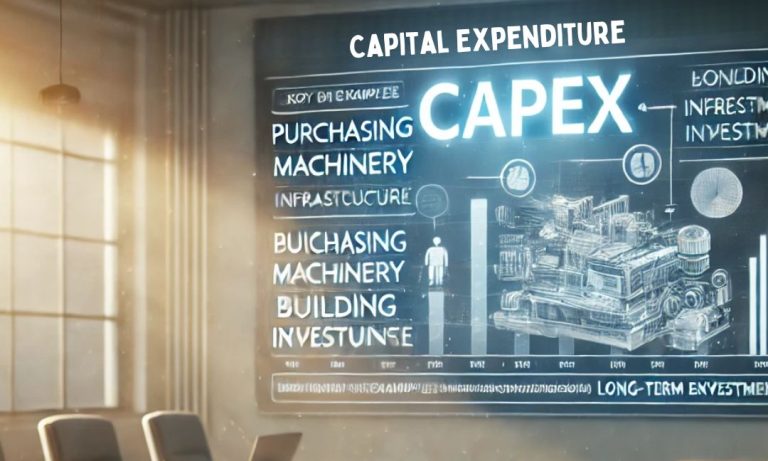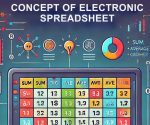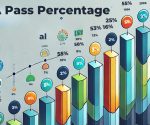Capital expenditure (CapEx) refers to the funds a business or organization invests in acquiring, upgrading, or maintaining fixed assets such as buildings, equipment, and machinery. These expenditures are made to support long-term growth and operational efficiency. Unlike operating expenses (OpEx), which are related to day-to-day operations, capital expenditures are used for purchasing or improving assets that will provide benefits over an extended period. Capital expenditures play a vital role in the financial health of an organization, influencing everything from production capacity to technological advancement.
What Are Capital Expenditures?
Capital expenditures (CapEx) represent the investments made by a business to acquire or upgrade long-term assets. These assets may include physical items like property, equipment, and machinery, or intangible assets like software and patents. Essentially, CapEx refers to any expenditure that a company makes to purchase, improve, or extend the life of its fixed assets.
The key distinguishing feature of capital expenditure is its long-term nature. Unlike operating expenses that cover short-term operational costs (like salaries, utilities, and raw materials), capital expenditures are made with the expectation of generating returns over many years. They are typically recorded as an asset on the balance sheet rather than an expense on the income statement, and their value is gradually depreciated over time.
Characteristics of Capital Expenditures
- Long-term: CapEx investments are intended to provide benefits over a long period (often 3 years or more).
- Asset Acquisition or Improvement: It includes purchasing new assets or upgrading existing ones to increase their efficiency or capacity.
- Depreciable: Fixed assets acquired through CapEx typically lose value over time, and depreciation is applied to reflect this decrease in value.
Examples of Capital Expenditures:
- Purchasing new machinery for production
- Building a new factory or office building
- Upgrading existing equipment or vehicles
- Acquiring land or real estate for business operations
- Developing software for internal business processes
Understanding Capital Expenditures
Capital expenditures are crucial for business growth and operational efficiency. By investing in fixed assets, businesses can enhance their production capacity, expand their operations, and improve their competitiveness. Understanding CapEx is important for both financial reporting and strategic planning.
Key Aspects of Capital Expenditures
- Long-Term Investment: CapEx represents an investment in the future. These assets are expected to provide value for years to come, such as machinery that helps in manufacturing or a new office building that can accommodate growing teams.
- Impact on Financial Statements: Since capital expenditures involve significant investment, they are recorded on the balance sheet as assets. Over time, their value is reduced through depreciation, and part of the expense is reflected on the income statement each year.
- Cash Flow Implications: Capital expenditures are often financed through business profits, loans, or issuing bonds. Businesses must carefully plan for these large expenses to ensure they don’t strain cash flow or liquidity.
- Approval Process: Unlike regular operational expenses, CapEx usually requires approval from higher management or the board of directors. These expenditures often involve significant sums, and their potential impact on the business must be carefully evaluated.
Why Businesses Make Capital Expenditures?
- Expansion: As businesses grow, they need more resources, infrastructure, and capacity to meet increased demand.
- Innovation: Businesses invest in research and development (R&D) or advanced machinery to stay ahead of the competition.
- Efficiency: Upgrading older equipment or technology can reduce operational costs and improve productivity in the long term.
Types of Capital Expenditures
Capital expenditures can be broadly classified into several types based on their purpose and function. Here are the main types of capital expenditures:
1. Expansion Expenditures:
These expenditures are made when a company expands its operations. It could involve building new factories, opening new branches, or acquiring additional land for business use.
- Example: A retail chain opening a new store in a different city.
- Impact: These expenditures aim to increase a company’s market presence and revenue generation capacity.
2. Replacement Expenditures:
These expenditures are made to replace old, obsolete, or broken equipment, machinery, or infrastructure.
- Example: Replacing aging production machinery with more efficient and up-to-date models.
- Impact: These expenditures help maintain operational efficiency without necessarily expanding the business.
3. Efficiency Enhancing Expenditures:
This type of expenditure focuses on improving the efficiency of existing assets or operations.
- Example: Upgrading a company’s software system or installing energy-efficient equipment.
- Impact: These investments aim to reduce costs and improve productivity, which ultimately boosts profitability.
4. Strategic Expenditures:
Strategic expenditures are made with the goal of gaining a competitive advantage in the market. This can include investments in research and development (R&D), mergers, or acquisitions.
- Example: Acquiring another company to expand the product range.
- Impact: These investments may not provide immediate returns but are made to position the company for future growth.
5. Repair and Maintenance Expenditures:
While not always categorized as CapEx, certain repair costs can fall under this heading if they extend the useful life of an asset.
- Example: Renovating an office building or upgrading HVAC systems.
- Impact: These expenditures ensure that existing assets remain productive and continue to provide value.
Formula and Calculation of CapEx
Capital Expenditure (CapEx) is typically calculated using the following formula:
This formula can be broken down as follows:
- Ending Net Fixed Assets: The value of all fixed assets at the end of the period (after accounting for depreciation and disposals).
- Beginning Net Fixed Assets: The value of all fixed assets at the start of the period.
- Depreciation: The total depreciation charged on the fixed assets during the period.
Example Calculation:
If a company’s net fixed assets at the beginning of the year were $2,000,000 and at the end of the year they were $2,200,000, with depreciation amounting to $100,000, the capital expenditure would be:
This means the company invested $300,000 in capital expenditures over the course of the year.
Examples of Capital Expenditures
To better understand capital expenditures, here are some practical examples that businesses might incur:
- Building or Buying Real Estate: If a company purchases a new office building or factory, the cost involved is classified as capital expenditure.
- Machinery and Equipment: A manufacturing company purchasing new machines for production is a typical example of capital expenditure.
- Technology Investments: A company investing in enterprise software or upgrading IT infrastructure to enhance its operations.
- Vehicle Purchases: A logistics company buying new trucks for transporting goods.
- Land Acquisition: Companies may purchase land to expand their operational footprint.
These expenditures require substantial capital outlay and are often planned over the long term, with the goal of improving efficiency, capacity, or competitiveness.
Conclusion
Capital expenditure (CapEx) is a critical aspect of business investment that helps companies maintain, expand, and enhance their operational capabilities. These expenditures are essential for long-term growth, and understanding their types, calculations, and impact is key for effective business management. By properly planning and allocating resources for capital expenditures, businesses can ensure they are well-equipped to meet future demands and stay competitive in their respective industries.
Capital Expenditure FAQs
What is the difference between capital expenditure and operating expenditure?
Capital expenditure involves long-term investments in assets like machinery and buildings, while operating expenditure is the cost incurred for daily business operations such as salaries and raw materials.
How is capital expenditure calculated?
CapEx is calculated as the difference between the ending and beginning net fixed assets, plus any depreciation charged during the period.
What are examples of capital expenditures?
Examples include purchasing machinery, acquiring land, building new office facilities, and upgrading technology.
Why is capital expenditure important for a business?
CapEx is vital for business growth, allowing companies to expand, innovate, and maintain efficient operations over the long term.
Can capital expenditures be financed?
Yes, businesses can finance capital expenditures through loans, bonds, or internal cash reserves, depending on the financial strategy.


